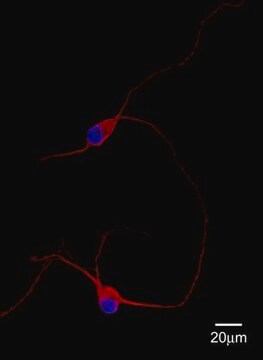推薦產品
一般說明
Microtubule-associated protein 2 (UniProt: P15146; also known as MAP-2) is encoded by the Map2 (also known as Mtap2) gene (Gene ID: 25595) in rat. MAP-2 belong to the family of thermostable proteins associated with microtubules. It is an abundant neuronal cytoskeletal protein that binds to tubulin and stabilizes microtubules against depolymerization. It also has a stiffening effect on microtubules. MAP-2 is shown to be essential for the development and maintenance of neuronal morphology. Three primary isoforms of MAP-2, the high molecular weight MAP2a and MAP2b, and the low molecular weight MAP2c (resulting from alternate splicing of the MAP2 gene) have been identified in neurons. The low molecular weight isoform, MAP2c, is expressed in developing brain and is down-regulated during brain maturation, whereas the high molecular weight MAP2b is expressed in both developing and adult brain. The MAP2a appears only after brain maturation. All these forms bind to microtubules through a domain near the carboxyl terminus that contains either three or four similar repeats of a 31-amino-acid motif. MAP-2 can be phosphorylated at serine residues in K-X-G-S motifs by MAP/microtubule affinity-regulating kinase (MARK1 or MARK2) that causes its detachment from microtubules and results in their disassembly.
特異性
Other homologies: Mouse (94% sequence homology). Human (72% sequence homology).
This antibody recognizes MAP-2.
免疫原
Three KLH-conjugated linear peptides corresponding to the N-terminal and central regions of rat MAP-2 .
應用
Anti-MAP-2 Antibody, Cat. No. AB2290, is a highly specific rabbit polyclonal antibody that targets rat MAP-2 and has been tested in Immunocytochemistry, Immunohistochemistry (Paraffin), and Western Blotting.
Immunocytochemistry Analysis: A 1:1,000 dilution from a representative lot detected MAP-2 in E18 rat hippocampus neurons.
Immunohistochemistry Analysis: A 1:1,000 dilution from a representative lot detected MAP-2 in mouse cerebellum, rat cerebral cortex, and rat kidney tissues.
Immunohistochemistry Analysis: A 1:1,000 dilution from a representative lot detected MAP-2 in mouse cerebellum, rat cerebral cortex, and rat kidney tissues.
Research Category
Neuroscience
Neuroscience
Research Sub Category
Neuronal & Glial Markers
Neuronal & Glial Markers
品質
Evaluated by Western Blotting in rat brain microsomal preparation.
Western Blotting Analysis: 1 µg/mL of this antibody detected MAP-2 in 10 µg of rat brain microsomal preparation.
Western Blotting Analysis: 1 µg/mL of this antibody detected MAP-2 in 10 µg of rat brain microsomal preparation.
標靶描述
~270 kDa observed; 202.41 kDa calculated. Uncharacterized bands may be observed in some lysate(s).
外觀
Affinity purified
Purified rabbit polyclonal antibody in buffer containing 0.1 M Tris-Glycine (pH 7.4), 150 mM NaCl with 0.05% sodium azide.
儲存和穩定性
Stable for 1 year at 2-8°C from date of receipt.
分析報告
Control
Rat brain microsomal tissue lysate
Rat brain microsomal tissue lysate
其他說明
Concentration: Please refer to the Certificate of Analysis for the lot-specific concentration.
免責聲明
Unless otherwise stated in our catalog or other company documentation accompanying the product(s), our products are intended for research use only and are not to be used for any other purpose, which includes but is not limited to, unauthorized commercial uses, in vitro diagnostic uses, ex vivo or in vivo therapeutic uses or any type of consumption or application to humans or animals.
未找到適合的產品?
試用我們的產品選擇工具.
儲存類別代碼
12 - Non Combustible Liquids
水污染物質分類(WGK)
WGK 1
閃點(°F)
Not applicable
閃點(°C)
Not applicable
分析證明 (COA)
輸入產品批次/批號來搜索 分析證明 (COA)。在產品’s標籤上找到批次和批號,寫有 ‘Lot’或‘Batch’.。
Sang Ah Yi et al.
Viruses, 12(9) (2020-09-12)
Since the global outbreak of SARS-CoV-2 (COVID-19), infections of diverse human organs along with multiple symptoms continue to be reported. However, the susceptibility of the brain to SARS-CoV-2, and the mechanisms underlying neurological infection are still elusive. Here, we utilized
Jian-Ying Tian et al.
Experimental and therapeutic medicine, 12(2), 683-689 (2016-07-23)
The aim of the present study was to observe the effects of a general extract of Lycium bararum polysaccharides (LBPs) on methylmercury (MeHg)-induced damage in hippocampus neural stem cells (hNSCs). The hippocampal tissues of embryonic day 16 Sprague-Dawley rats were
我們的科學家團隊在所有研究領域都有豐富的經驗,包括生命科學、材料科學、化學合成、色譜、分析等.
聯絡技術服務